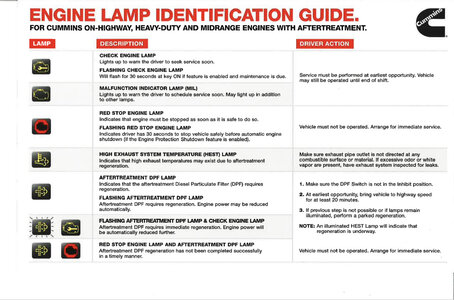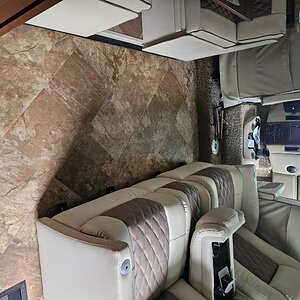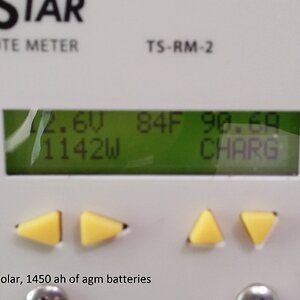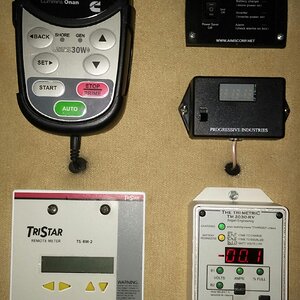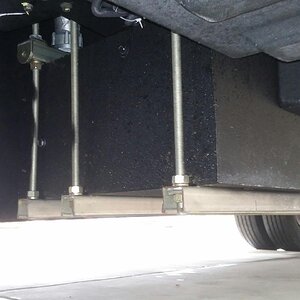Either way is fine because as long as it senses enough differential pressure between the inlet and outlet of the DPF it’s going to start a regen as soon as conditions are right (engine rpm, road speed, and exhaust temp). So if its in the middle of a regen while you're at highway speed and you interupt it by getting off, whether for fuel for 30 minutes, or overnight or longer, and it has not burned off enough soot, it will start again as soon as conditions allow. Spartan may be saying “keep driving” to be on the safe side, but it isn’t necessary.
What you don’t want to do is continue to drive at low speeds (under about 55mph) for an extended period of time (more than a couple hours) because at some point the system will give up trying to regen and put you into derate. This is from the system designers to keep you from ignoring the issue, potentially damaging your DPF, and of course causing permenant injury to the planet, just like the low DEF issue. I’ve read you have as much as four hours to perform a regen once the lamp illuminates, but as
@Neal recently found, this can sneak up on you pretty fast. It shouldn’t and I don’t know why his did - I would have said it wouldn’t and been wrong.
All that said, I’m a firm believer in the more regens the better, and I have several adjuncts to perform them manually. So if its at all feasible, I’d give it the opportunity to finish a regen any time the sensors initiate one, although I would probably not pass my exit and just drive until its done, because I can easily perform a manual regen. As far as I know, it can’t finish an active regen on its own once you stop. Maybe Spartan added this feature, but I’ve never read any accounts of a regen self-initiating when parked - it will always wait until driving conditions are right again, or for manual initiation if parked. It can’t detect if you are in a safe location so by design, it won’t start on its own unless you are driving.
There are three stages or regen: passive which is just the process of soot burning off in the DPF when exhaust temp is high enough (around 700°, no dash indicators, no diesel injected into the exhaust), active which includes the injection of diesel while driving (1100° +, high exhaust temp, still no DPF lamps on unless you slow down or stop), and parked/forced/manual regen (they may even be other names for it but its all the same thing) where the operator finds a safe place to perform a regen and has the time to sit for an hour or so, and initiates the regen either by a switch on the dash (truckers), the “shorting plug” (FL chassis coaches for a number of years - not sure on new ones), or with an external device that plugs into the J1939 port and has regen capabilities. But Spartan may have devised and installed other means for the operator to start a regen - I don’t know.
It doesn’t surprise me that you are getting a variety of opinions elsewhere (especially on FB which is probably the worst place to get any information on anything), because there is so little training or preparation for new owners of these systems and usually people are forced into guesswork when a problem arises. Truckers learn all about this in trucker school, but when have you ever known a dealership to pair a customer with a competent, qualified tech to provide an in-service on these things? If they did, half the potential buyers would probably walk, and that’s assuming the dealership has any qualified people to educate you on the process.
So that’s my .02 worth on this. I’ve done everything but attend a class on these systems (including replacing a differential pressure sensor) and I still haven’t ruled out the class. These are complex, fragile systems forced on consumers before the technology was ready for the mobile environment so we are stuck either figuring them out or risking a tow and paying the the big bucks to fix them. Fortunately, 10 years after this form of emissions control was introduced, they are finally starting to operate more reliably. But they can still leave you stranded, so the more you know about it, the better.
Edit: Looking at your dash I don’t see the industry standard HEST or After-treatment DPF lamps, so it appears Spartan has done away with this in favor of a ”clear text” approach (maybe all glass dashes?). This is the first I’ve seen of it, but it also tells me there may be other differences on a Spartan Chassis. They certainly took a different approach on their DEF heads over the years, much to the detriment of coach owners. I’m guessing DTE 700mi is the DEF Tank Empty indicator - another difference. So a call to Spartan would be a good idea, and maybe you can provide more info based on their response.
